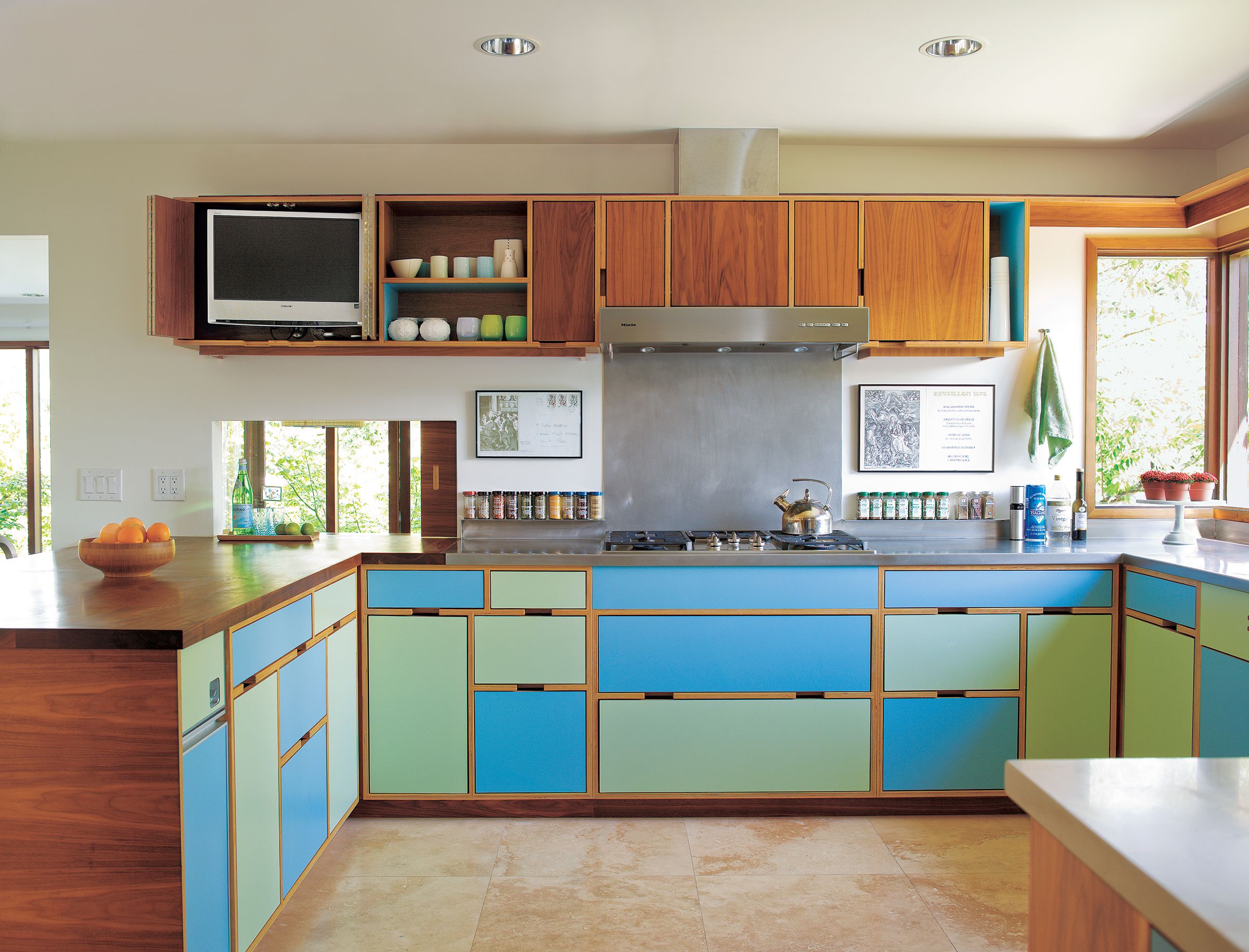Laminate can give the most mundane surface the look of polished granite, exotic hardwood, vibrant enamel paint, or patterned wallpaper. It’s durable, easy to maintain, and water-resistant. In this guide, we’ll tell you all about laminate, its benefits and disadvantages, and where you can use this versatile material in your home.

Similar to shown: Verde Acido and Blue Valencia, Decotone Surfaces
What Is Laminate and How Is It Made?
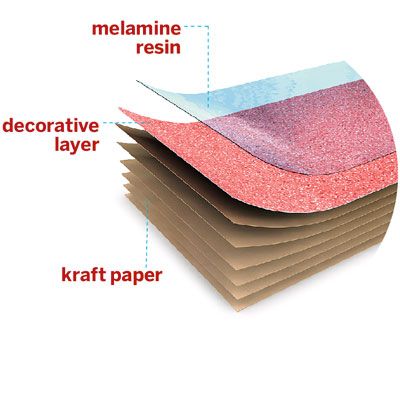
Laminate is a synthetic material. It has four main layers, which include:
- Backing layer: A moisture-resistant bottom layer that provides stability
- Decorative layer: A printed paper or foil that gives laminate its appearance
- Kraft paper layer: A stiff, resin-saturated backing that sticks well to adhesives
- Melamine resin layer: A transparent, protective top coat
Heat and pressure fuse these layers together to create a durable, water-resistant material that’s barely thicker than a credit card. It can withstand a lot of wear and tear and doesn’t really scratch, fade, or stain.
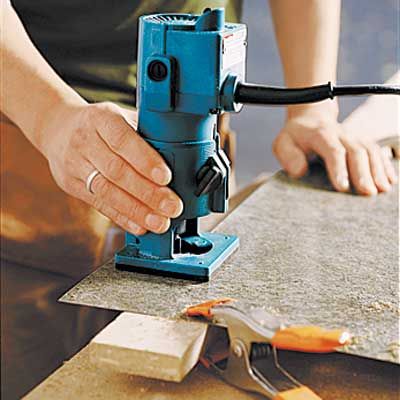
Types of Laminate
Laminate comes in three main types. We’ll explain each and break down their uses below:
High-Pressure Laminate (HPL)
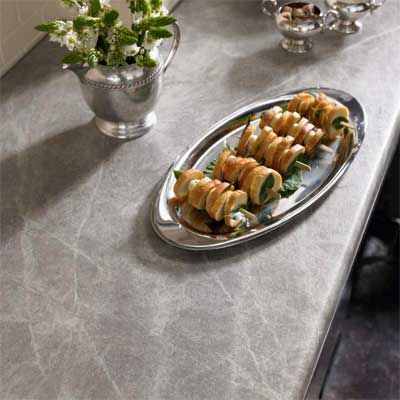
High-pressure laminate is the most durable out of the three, so many homeowners use it in high-traffic areas and horizontal surfaces. Manufacturers glue particleboard or medium-density fiberboard to HPL sheets to add to its strength and stability. HPL comes in two grades:
- Thick grade: Used for countertops, tables, and desktops
- Thin grade: Suitable for vertical surfaces, such as wall panels and cabinet doors
Low-Pressure Laminate (LPL)

Low-pressure laminate is also called melamine. Manufacturers bond this single decorative layer to a substrate such as particleboard or medium-density fiberboard (MDF). It’s a cost-effective option even though it isn’t as strong as HPL. Homeowners use LPL for:
- Cabinet interiors
- Shelving
- Vertical surfaces
Thermoplastic Laminate
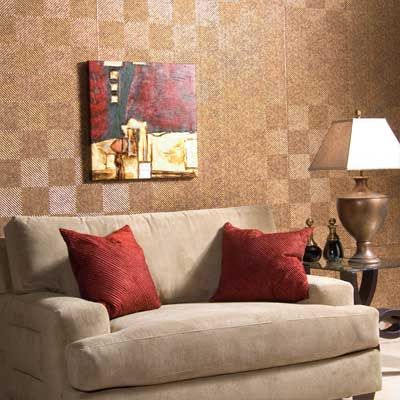
Thermoplastic laminate is made from layers of plastic or plastic topped with metal foils or paper. They’re found in decorative wall panels and other specialty applications. Thermoplastic laminate provides:
- Bold, three-dimensional textures
- High-gloss finishes
- Unique design possibilities
Benefits and Drawbacks of Laminate
Even though laminate has many benefits, there are some drawbacks to using this material. Advantages of choosing laminate include:
- Affordability: Less expensive than natural materials, such as stone or hardwood
- Durability: Resists scratches, stains, and water damage
- Easy installation: DIY enthusiasts can install many different types
- Low maintenance: Easy to clean and doesn’t require sealing or polishing
- Versatility: You can find laminate in a variety of colors, patterns, and textures
A few disadvantages to opting for laminate are:
- Difficult to repair: You’ll have to replace the entire panel if it gets damaged
- Environmental concerns: Not biodegradable, you can’t really recycle it
- Heat sensitivity: You can damage laminate by placing hot pots or pans on it
- Lower resale value: Doesn’t usually add value to a home
Popular Laminate Patterns and Designs
You can find laminate in many patterns and designs to suit your individual taste. Some are inspired by wood or stone materials while others have unique designs. We explain some of these below:
Abstract Patterns
Abstract patterns have a modern, artistic look. Examples include:
- Boomerang designs reminiscent of mid-century modern look
- Bubble-inspired textures for a playful touch
- Ripple patterns that add visual interest to vertical surfaces
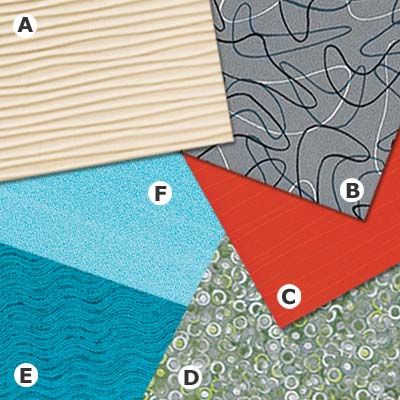
A. Beach dune: This paintable thermoplastic laminate has a 3-D texture resembling windblown sand; EccoFlex Mojave from ATI Decorative Laminates
B. Boomerangs: Created by Raymond Loewy in the 1950s, this is a classic example of mid-century modern design; Charcoal Boomerang from Formica Group
C. Red ripple: Sculpted grooves add shadow lines to vertical applications; Grenadine from Formica Group
D. Tiny bubbles: This anime-inspired pattern is embedded in a high-pressure laminate; Beluga from Formica Group
E. Blue wave: A wavy pattern reminiscent of finger paint adds a fun touch to counters; Blue Agave from Wilsonart
F. Blue shimmer. Streaked with sparkles, the surface has a pearlescent sheen; Beryl Wisp from Lamin-Art
Metal-Look Laminates
These look just like metal but carry the weight that typically comes with metal surfaces. They’re also less expensive. Options include:
- Brushed aluminum finishes
- Hammered copper effects
- Patinated brass looks
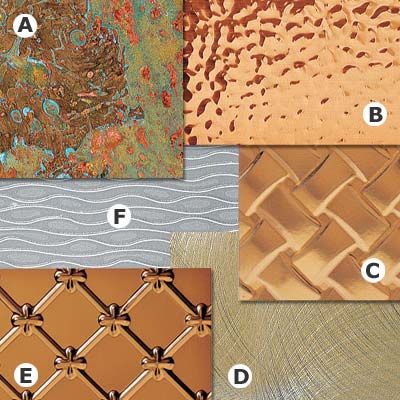
A. Patinated metal: An oxidizing agent applied to real brass makes every sheet unique; Melrose, Metal Images Collection from Chemetal
B. Hammered copper: A foil applied to bumpy plastic looks like the real thing. Use only on walls; MirroFlex Hammered from ATI Decorative Laminates
C. 3-D texture: A dimensional pattern and faux metal finish make an eye-catching backsplash; MirroFlex Celtic Weave from ATI Decorative Laminates
D. Metal swirl: It’s real brushed aluminum for use on vertical surfaces; DecoMetal Goldtone Crush from Formica Group
E. Victorian lattice: The raised pattern on this laminate evokes a pressed-tin ceiling panel; MirroFlex Annapolis from ATI Decorative Laminates
F. Wavy metal: Actual aluminum is embossed with a striated pattern; Deco MetalAluminum Twirl from Formica Group
Stone-Inspired Designs
These look like stone but at a fraction of the cost. Popular choices include:
- Concrete-inspired finishes for an industrial look
- Granite patterns with veining
- Marble-look designs for a luxurious feel
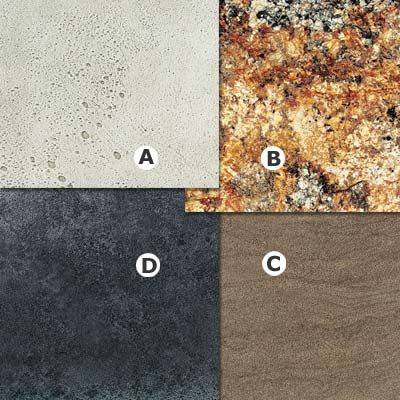
A. Concrete: Marble sand gives this laminate the look and feel of cast concrete; ConcreteLite from ATI Decorative Laminates
B. Granite: Its pattern spans 5 feet (18 inches is the norm); Golden Mascarello from Formica Group
C. Sandstone: This matte-finish HPL convincingly mimics sandstone; Verdicts In from Panolam
D. Rough stone: The textured Aeon surface contains aluminum oxide for high scratch resistance; Luna Night from Wilsonart
Fabric Finishes
You can use fabric laminates on tents, quilts, and other products you’d like to reinforce. Fabric laminate can provide:
- Leather-inspired effects
- Organic looks
- Textured appearance but smooth to the touch
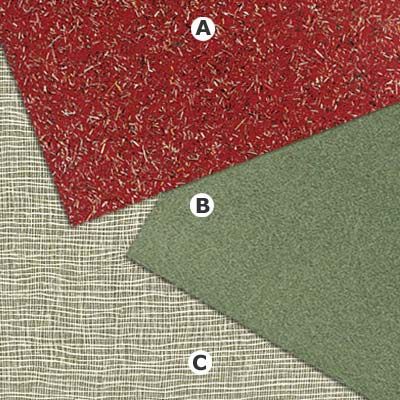
A. Natural fiber: A mix of banana-tree fibers imparts an organic look; Crimson Abaca from Lamin-Art
B. Moss green: This multi-tonal, matte-finish HPL has a pattern that resembles fine-grain leather; Vous Verde from Panolam
C. Loose weave: The cheesecloth looks rough, but the surface is smooth; Possum Warp from Formica Group
Wood Grain Laminate
Wood grain laminates offer the warmth of wood without the maintenance. Styles include:
- Classic oak and maple finishes
- Exotic wood looks like wenge or bamboo
- Whitewashed or weathered wood effects
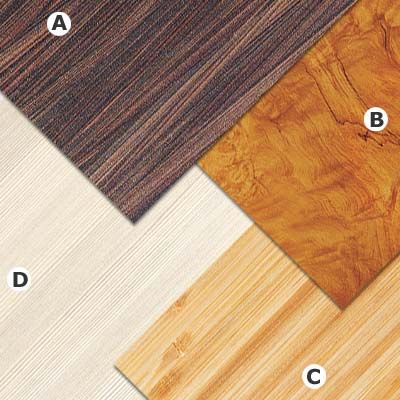
A. Tropical timber: It looks like a hardwood, but it’s actually a photographic print set in HPL; Wenge Strand from Formica Group
B. Shiny burl: The high-gloss acrylic finish shines like lacquer on table tops and walls; ClearCore Medium Teak from ATI Decorative Laminates
C. Bamboo: Authentic pressed bamboo for vertical surfaces has a water-, stain-, and scratch-resistant finish; Veneer-Art Natural Bamboo from Lamin-Art
D. Whitewash: It captures the soft look of pickled antique pine; Leave Likatre from Panolam
Where To Use Laminate in Your Home
You can use laminate in many spots throughout your home. Here are a few ideas:
In the Kitchen
You can use laminate on:
- Cabinet doors and drawer fronts: Provides a consistent look at an affordable price
- Countertops: Offers durability and easy cleaning
- Backsplashes: Creates a seamless, water-resistant surface
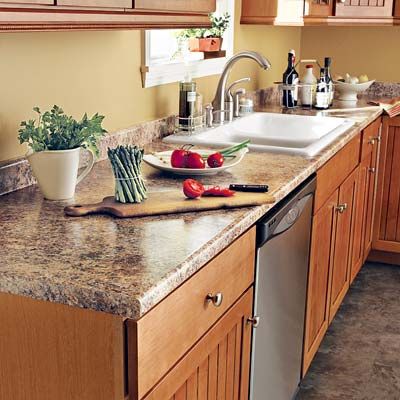
Similar to shown: Finished counter in Formica’s Butterum Granite from L. E. Smith Company
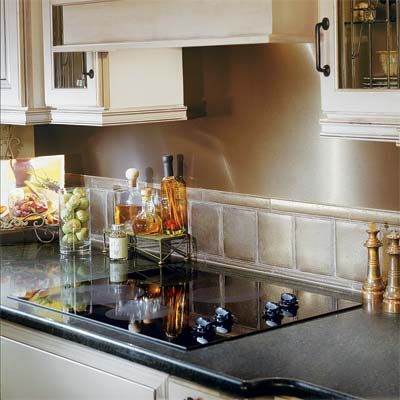
Similar to shown: Satin Brushed Copper from Wilsonart
Bathroom Uses
You might find laminate in a bathroom on:
- Cabinet exteriors: Withstands humidity and frequent use
- Vanity tops: Resists water and cosmetic stains
- Wall panels: Creates a moisture-resistant, easy-to-clean surface
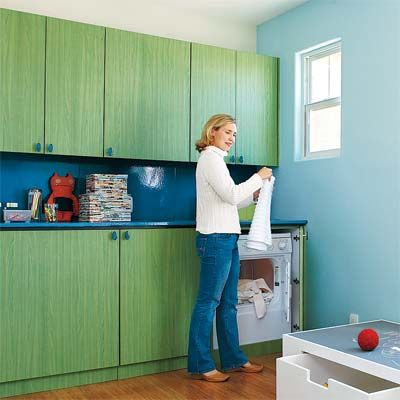
Similar to shown: Legni Colorati 1673 Soft from ABET Laminati
Living Space Ideas
Aside from bathrooms and kitchens, consider using laminate for:
- Flooring: Provides a durable, affordable alternative to hardwood
- Furniture: Tables, desks, and shelving units
- Wall paneling: Adds texture and interest to accent walls
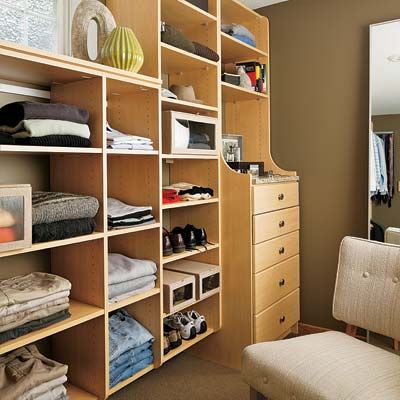
Similar to shown: Custom melamine shelving system in Maple from California Closets
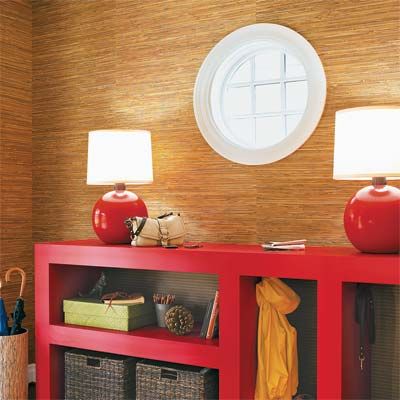
Similar to shown: Spectrum Red from Formica Group
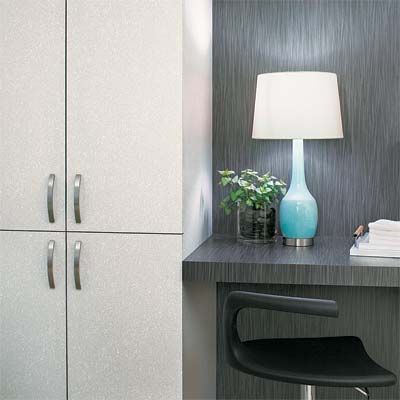
Similar to shown: Burnt Strand from Formica Group
Where To Buy Laminate
A few tips on where to find laminate include:
- Buy panels at home centers or get the melamine sheets from online sellers, such as BAND-IT, and iron them onto a substrate yourself.
- One company, ATI Decorative Laminates, sells through distributors listed on its website.
- To find out where sheets and prefab counters and panels with backing already adhered are sold, go to manufacturer websites, such as Formica Group and Wilsonart.
Cost, Installation, and Maintenance of Laminate
Laminate is an affordable alternative to other materials, but costs go up if you hire someone to install it for you or if you opt for high-end finishes or customization. Prices are also different depending on where you’re using it. The cost breakdown below includes averages over countertop and floor laminates:
- Countertops: The average price for countertop laminate is between $842 and $1,734*.
- Flooring: Laminate flooring costs on average between $1,472 and $4,640.
*Cost data in this section sourced from Angi
The way you install your laminate will affect its lifespan and appearance. Some homeowners with do-it-yourself (DIY) experience can install it themselves, but you might benefit from hiring a professional if you aren’t familiar with DIY projects. We have some tips below depending on which approach you take.
DIY Installation Tips
If you’re planning on installing laminate yourself:
- Allow proper curing time before use
- Make sure the substrate is clean, dry, and level
- Match the correct adhesive to the laminate type you’ve chosen
- Use specialized tools, such as a laminate roller
Professional Installation Considerations
You might want to consider hiring some help if your project includes:
- Complex countertop designs with integrated sinks
- Curved or unusual shapes requiring precise cutting
- Large-scale commercial projects
- Warranty requirements
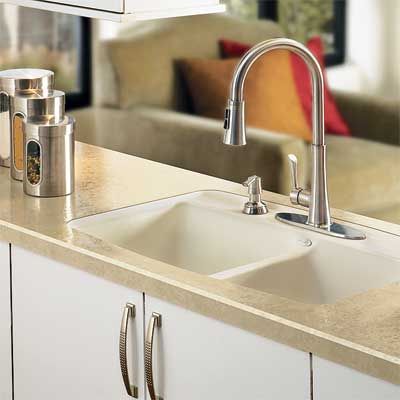
Sinks, from Wilsonart (shown) and Karran, must be professionally installed in laminate.
Cleaning and Care Guidelines
Follow the tips below to keep your laminate in tip-top shape:
- Avoid harsh chemicals or abrasive scrubbers
- Clean with mild soap and water or non-abrasive cleaners
- Use trivets or hot pads to protect from heat damage
- Wipe up spills promptly to prevent staining
Laminate Edge Treatments and Upgrades
Laminate is durable, but there are upgrades to make it even stronger. You can also enhance its appearance by using edge treatments. We’ve covered a few of those options below.
Metal Edging Options
Metal edging looks retro and industrial. Check out some of the options you have to consider:
- Clip-on edges for easy DIY installation
- Custom-cut metal edges for a seamless appearance
- Stainless steel or aluminum banding for a diner-style look
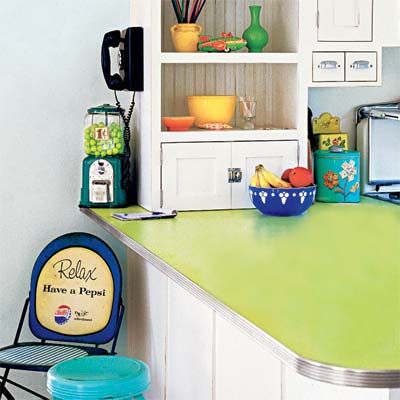
Shown: Stainless clip-ons from L. E. Smith Company
Wrapped Edges
If you want your laminate to have a more seamless look, go for wrapped edges. A few choices for wrapped edges include:
- Bullnose or ogee profiles for a softer appearance
- Eased edges for a modern, streamlined look
- Factory-applied for professional results
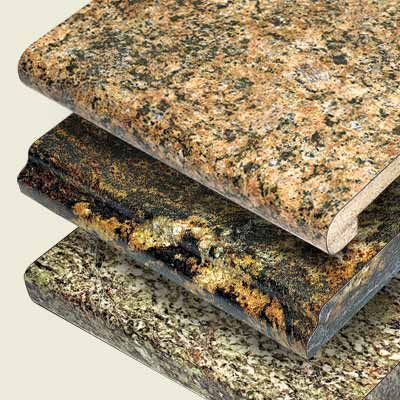
Order this treatment through a home center or a fabricator and get a ready-to-install—find fabricators through VT Industries.
Beveled Edges
Looking for some sophistication? You can opt for beveled edges, which have a few benefits, including:
- Can be DIY-applied or professionally installed
- Get a clean and angular look with 45-degree bevels
- Less prone to chipping than square edges
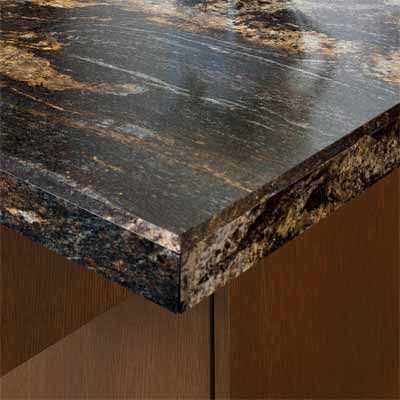
A 45-degree bevel at the top of the counter’s edge has less chance of chipping or coming loose than a standard square edge.
Similar to shown: DIY strips from KUEHN Bevel
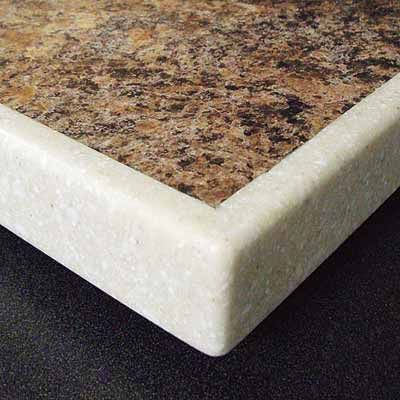
The durable, low-maintenance material, held on with an acrylic adhesive, can be cut and shaped like wood but doesn’t require a protective finish.
Similar to shown: Pro-installed strips from KUEHN Bevel.
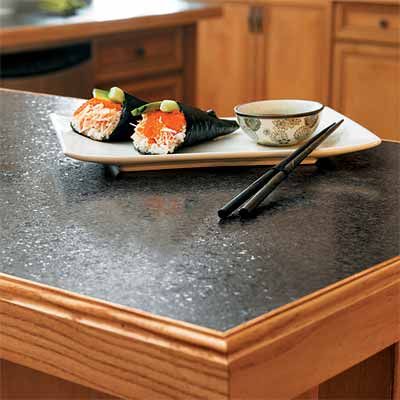
Hardwood adds a warm, natural touch to laminate’s man-made coolness. Wood can easily be shaped into different profiles, but it needs a water-resistant finish, such as tung oil.
Similar to shown: Red oak bullnose Baird Brothers.
Comparing Laminate To Other Materials
Below, we’ll compared some surfaces against laminate if you’re still on the fence about choosing it over a different material.
- Laminate versus natural stone: You’ll have less maintenance if you opt for laminate instead of stone, which needs resealing every so often. However, you’ll find that stone can resist heat when compared to laminate-like stone.
- Laminate versus solid surface: Laminate is less expensive than solid surface, but it’s also less flexible. You can repair solid surfaces, but you’ll likely have to replace laminate if it gets damaged.
- Laminate versus wood: Wood provides a more natural and authentic look. You can also sand or refinish it, but laminate is much more water-resistant.
Environmental Considerations of Laminate
If you’re someone who practices sustainability or you’re concerned about your family’s health, consider the following tips:
Recycled Content in Laminates
Some manufacturers incorporate recycled materials:
- Look for products with high recycled content for eco-friendly options
- Post-consumer plastic in certain laminate types
- Recycled paper in the kraft paper layers
VOC Emissions and Air Quality
Breathing in volatile organic compounds (VOCs) isn’t good for your lungs. Consider air quality when choosing laminate:
- Allow proper ventilation after installation to minimize off-gassing
- Look for low-VOC or Greenguard-certified products from places such as Panel Source and Uniboard
- Use low-VOC adhesives during installation
Sustainability Factors
Aside from searching out recycled materials, you can practice sustainability when using laminates by considering:
- Durability and longevity of the product
- Energy efficiency in manufacturing processes
- End-of-life recyclability or disposal options
Troubleshooting Common Laminate Issues
Laminate is durable, but you can still run into issues. Here are a few tips based on what could go wrong with your laminate:
Dealing With Burns and Chips
For minor damage:
- Consider a heat-proof insert for burn damage or use a product such as Surface Saver from Vance Industries, Inc.
- Replace severely damaged sections if necessary
- Use color-matched repair paste for small chips
Addressing Delamination
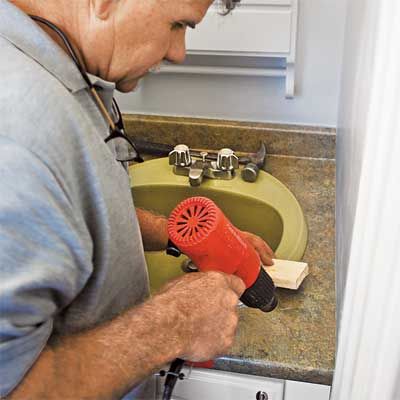
If laminate begins to separate from the substrate:
- Press the laminate back in place with a rolling pin
- Use a hair dryer or heat gun to reactivate the adhesive
- Weight down the area for 24 hours to ensure proper adhesion
Stain Removal Techniques
For stubborn stains:
- Apply to the stain and cover with plastic wrap overnight
- Avoid abrasive cleaners that can scratch the surface
- Create a paste of baking soda and water
- Rinse thoroughly in the morning
By following these steps, your laminate products will last long and maintain their beauty.
